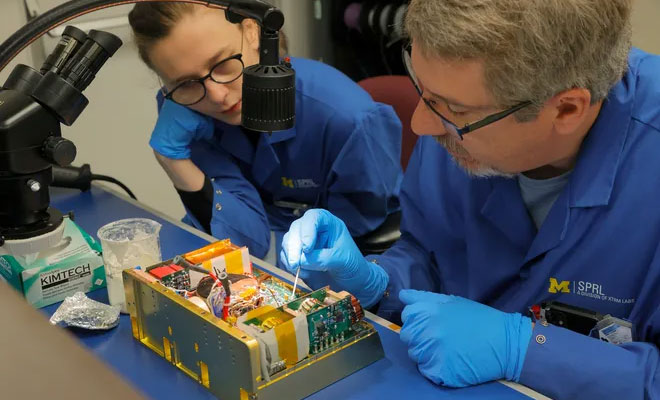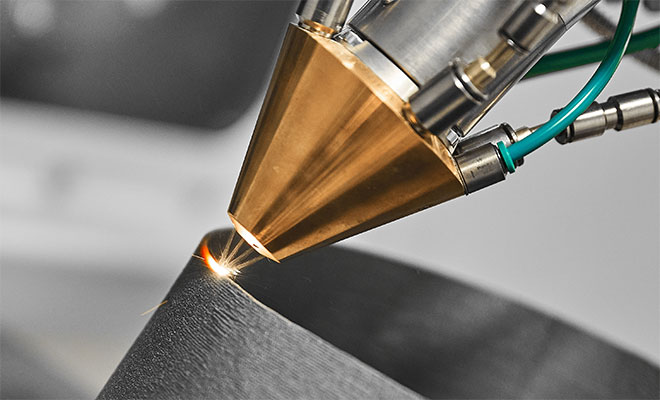america's aerospace future needs michigan
Today, more than 900 Michigan companies impact the global aerospace industry.
Michigan’s history in aerospace began more than 80 years ago, during World War II, when Ford Motor Company showed the world how an aircraft could be built on an assembly line. In 1941, the automaker began construction on a nearly 3.5-million-square-foot manufacturing facility. The Willow Run Bomber Plant ultimately produced 8,685 B-24 bombers by the end of the war in 1945.
This intersection between the automotive and aerospace industries didn’t stop when the war ended. Companies continued to invest and expand their aerospace assets in Michigan, leveraging the state’s talent and expertise in engineering, tooling, and manufacturing. Today, Michigan is home to one of the largest aerospace clusters in the country.
energizing core aerospace sectors
Commercial
Primes are demanding higher quality products to meet AS9100 standards.
Michigan is the fastest-growing state in AS9100 certifications.
satellite & space
This aerospace sector needs an ecosystem of the most innovative engineers, advanced manufacturers and a reliable supply base in order to grow.
Michigan has the most engineers per capita of any state and a powerful ecosystem of advanced manufacturers and suppliers.
DoD
$94 billion+ to prioritize innovation in aerospace, autonomy, artificial intelligence, hypersonics and emerging technologies.
Michigan is the third-highest-ranking DoD supplier in America.
Air mobilty
The Urban Air Mobility (UAM) market is projected to grow from $2.6 billion to $9.1 billion by 2030.
Michigan is in full-scale prototype stages for electric vertical takeoff and landing tilt-wing vehicles.

michigan aerospace
The entire lifecycle for aerospace is represented in Michigan.
- Michigan has a unique cluster of companies and universities dedicated to advancing lightweight materials. The state also has two federally funded light-weighting institutes — LIFT & IACMI in Detroit — conducting classified work in heat signaturing.
- Michigan can leverage aerospace talent and technologies to advance automotive to autonomous, specifically in electronic propulsion and mobility.
- Michigan can build major high-quality components to AS9100 standards with a high concentration of precision tooling and fabrication companies needed for aerospace.
- Michigan leads in manufacturing advanced systems and commercial and defense applications such as fan blades and fuel nozzles for numerous commercial and defense aircraft engines, flight control systems, main computer systems and networks for commercial aircraft, seating for aircraft, and many other key parts for all of the commercial and defense aircraft primes.
- Michigan has a large presence in aftermarket support and services. Since an aircraft often remains in service for 30-40 years, the maintenance, repair and overhaul (MRO) is highly regulated and critical to the industry.
Michigan leads in manufacturing and innovation.
- According to NSF, Michigan is one of America’s top-performing states for public R&D expenditures.
- Michigan has a significant amount of research universities engaged in both public and private aerospace programs. University of Michigan has the oldest aerospace program in the country, dating back to 1914.
- University of Michigan’s Space Institute is on course to be a world leader in space. From space weather to statistical mathematics, this program is advancing ideas, concepts, theories and technologies.
- Metal additive manufacturing (3D) in Michigan is already competitive and robust. Companies are actively prototyping and producing flight-critical components.
- Michigan’s federally funded light-weighting institutes — LIFT & IACMI in Detroit — represent a significant investment of $200 to 300 million, which includes funding from the US Department of Defense.
- Michigan’s commitment to broadband and satellite is a key asset in attracting companies, business and talent to every corner of the state.


Aerospace Capabilities in Michigan
- Aircraft & Rotocraft Production
- eVTOL
- Engines & Critical Engine Component
- Avionics
- Fuel Systems
- Flight Controls
- Super Alloy Castings
- Machining
- Major Structural Tooling
- Aircraft Interiors
- Pilot Training
- Space Technology
- Satellite Propulsion
- Satellite Production
- Automation
- Industry R&D
- Non-Destructive Testing
- Surface Treatment
- Packaging
- Engineering Services
- Electronics
- Motion Control
- Hydraulics
- Airframe & Powerplant Technician Training
- Wireless Measurement Systems
- Composites
- Thermo Analytics
- Wire Harness
- Printed Circuit Boards
- Structural Components
- Landing Gear
- Inventory Management
- Support Equipment
- 3D-Printing (Additive Manufacturing)
- Aftermarket Maintenance, Repair & Overhaul
- Electromechanical Instruments
- Low Altitude Authorization & Notification Capability (LAANC).

Aerospace Quality
Michigan is one of the fastest growing states in the country for companies achieving AS9100 certification.
2022 Top AS9100 States for Aerospace Product Manufacturing & Services
By Growth
| State | Count | Rank | Added | Growth |
|---|---|---|---|---|
| Colorado | 144 | 19 | 25 | 21.0% |
| Utah | 114 | 23 | 17 | 17.5% |
| Maryland | 112 | 24 | 15 | 15.5% |
| North Carolina | 131 | 20 | 17 | 14.9% |
| Michigan | 278 | 10 | 32 | 13.0% |
| Illinois | 266 | 12 | 29 | 12.2% |
| Pennsyllvania | 330 | 7 | 32 | 10.7% |
| Wisconsin | 110 | 25 | 10 | 10.0% |
| New Hampshire | 124 | 21 | 11 | 9.7% |
| Alabama | 192 | 14 | 17 | 9.7% |
| Florida | 444 | 3 | 34 | 8.3% |
| Oklahoma | 118 | 22 | 9 | 8.3% |
| New Jersey | 177 | 16 | 13 | 7.9% |
| Ohio | 390 | 6 | 25 | 6.8% |
| Connecticut | 400 | 5 | 25 | 6.7% |
| Minnesota | 145 | 18 | 9 | 6.6% |
| Arizona | 324 | 8 | 20 | 6.6% |
| New York | 402 | 4 | 21 | 5.5% |
| Georgia | 149 | 17 | 7 | 4.9% |
| Inidana | 186 | 15 | 7 | 3.9% |
| California | 2125 | 1 | 70 | 3.4% |
| Massachusetts | 274 | 11 | 7 | 2.6% |
| Washington | 308 | 9 | -11 | -3.4% |
| Texas | 449 | 2 | -36 | -7.4% |
| Kansas | 211 | 13 | -18 | -7.9% |
By Rank
| State | Count | Rank | Added | Growth |
|---|---|---|---|---|
| California | 2125 | 1 | 70 | 3.4% |
| Texas | 449 | 2 | -36 | -7.4% |
| Florida | 444 | 3 | 34 | 8.3% |
| New York | 402 | 4 | 21 | 5.5% |
| Connecticut | 400 | 5 | 25 | 6.7% |
| Ohio | 390 | 6 | 25 | 6.8% |
| Pennsylvania | 330 | 7 | 32 | 10.7% |
| Arizona | 324 | 8 | 20 | 6.6% |
| Washington | 308 | 9 | -11 | -3.4% |
| Michigan | 278 | 10 | 32 | 13.0% |
| Massachusetts | 274 | 11 | 7 | 2.6% |
| Illinois | 266 | 12 | 29 | 12.2% |
| Kansas | 211 | 13 | -18 | -7.9% |
| Alabama | 192 | 14 | 17 | 9.7% |
| Indiana | 186 | 15 | 7 | 3.9% |
| New Jersey | 177 | 16 | 13 | 7.9% |
| Georgia | 149 | 17 | 7 | 4.9% |
| Minnesota | 145 | 18 | 9 | 6.6% |
| Colorado | 144 | 19 | 25 | 21.0% |
| North Carolina | 131 | 20 | 17 | 14.9% |
| New Hampshire | 124 | 21 | 11 | 9.7% |
| Oklahoma | 118 | 22 | 9 | 8.3% |
| Utah | 114 | 23 | 17 | 17.5% |
| Maryland | 112 | 24 | 15 | 15.5% |
| Wisconsin | 110 | 25 | 10 | 10.0% |
Our Strong Talent Pipeline
West Michigan Aviation Academy – Located on the campus of the Gerald R. Ford International Airport in Grand Rapids, MI.
- Tuition free charter high school
- Students can earn a private pilot’s license as part of their 4-year high school program
- Academics focus on aviation, STEM and Advanced Placement programs
Lansing Community College – Lansing
- Airframe Maintenance and Powerplant Maintenance (2-year certificate)
MIAT College of Technology
- Airframe Maintenance and Powerplant Maintenance (2-year certificate)
Kent County Technical Center (KCTC) – Grand Rapids
- Airframe and Powerplant (A&P) certification (prep)
Lawrence Technological University – Southfield
- Aeronautical Engineering (Minor)
University of Michigan – Ann Arbor
- Aerospace Engineering (BS, MSE & PhD)
- Space Science & Engineering
- U-M Space Institute
Western Michigan University – Kalamazoo
- Aerospace Engineering (BSE)
- Aviation Flight Science (BS) – College of Aviation
- Aviation Management & Operations (BS)
- Aviation Technical Operations (BS)
Michigan Technological University – Houghton
- Aerospace Engineering (Minor)
- Aerospace Studies (Minor)
- Aerospace Enterprise
- Ion Space Propulsion Lab
- Undergraduates design, build, and fly small satellites for agencies such as NASA and the Department of Defense.
8 institutions with an aerospace focus fuel the Michigan pipeline.
At 60k+ per capita, Michigan has the largest concentration of engineers of any state in the country.
Aftermarket
The entire lifecycle for aerospace exists in Michigan, including a large presence in aftermarket support and services. Since an aircraft often remains in service for 30-40 years, the maintenance, repair and overhaul (MRO) is highly regulated and critical to the industry.

Duncan Aviation – Battle Creek
- General Aviation (Business Aircraft)
- Heavy maintenance, interior customization & updates
- 600+ employees

Spirit Airlines – Detroit Metropolitan Airport
- Built a new maintenance hangar ($32 million investment) in 2017.
- Some heavy maintenance and line maintenance. New aircraft for their fleet are delivered to the hanger at Metro without seats. The seats are installed in Detroit and then the aircraft is put into service.
- 140 employees
Delta Airlines – Detroit Metropolitan Airport
- Line maintenance

Envoy Air – K.I. Sawyer Airport Air Force Base (retired) – Marquette
- Regional Carrier for American Airlines
- Heavy maintenance
- 150-200 employees

Kalitta Air – Wurtsmith Air Force Base (retired), Oscoda
- Heavy maintenance
- 1,000 employees
- Their corporate offices a base for overall flight operations is located at Willow Run Airport.
